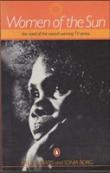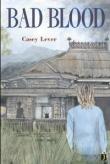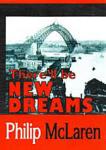
-
 This image has been sourced from Web.Though these four women 'lived in different eras they shared the same resilience and spirit - these Women of the Sun ...This quartet of stories speaks with the simplicity and power of the Aboriginal voice, illuminating from their perspective the experience of two centuries of white domination'. (Source: Back Cover, Penguin Books 1987 edition) (...more)See full AustLit entry
This image has been sourced from Web.Though these four women 'lived in different eras they shared the same resilience and spirit - these Women of the Sun ...This quartet of stories speaks with the simplicity and power of the Aboriginal voice, illuminating from their perspective the experience of two centuries of white domination'. (Source: Back Cover, Penguin Books 1987 edition) (...more)See full AustLit entryThis novelisation of the four-part television series Women of the Sun includes a brief introductory story, 'Towradgi', followed by a quartet of thematically related stories: 'Alinta, the Flame', 'Maydina, the Shadow', 'Nerida, the Waterlily', and 'Lo-Arna, the Beautiful'.
-
 This image has been sourced from online.See full AustLit entry
This image has been sourced from online.See full AustLit entry'A secret spans five generations from Cornwall to Australia.
'Who was Zenna Dare?
'When Jennefer moves to the old family home in country Kapunda, she uncovers a secret from the past. What sort of life did Gweniver, her great-great-great-grandmother, lead? And what connection did she have to the glamorous young singer, Zenna Dare?
'Could a nineteenth-century mother of nine have led a double life, and, if so, why?
In a story crossing five generations, from the old world to the new, Zenna Dare brings reconciliation in more ways than Jenefer could ever have imagined.
(...more) -
 This image has been sourced from online.See full AustLit entry
This image has been sourced from online.See full AustLit entry'The novel has been written as a dual narrative telling the story from the point of view of both fifteen year Will today and Ruby, an Indigenous servant girl, in the 1940's. Events play themselves out as past and present collide. Explored themes are family and belonging, secrets, identity and the 'Stolen Generation'.'
Source: http://au.wiley.com (Cited 24/05/2012)
(...more) -
 This image has been sourced from online.See full AustLit entry
This image has been sourced from online.See full AustLit entry'First published in 1923, The Incredible Journey tells the story of Iliapa, an Aboriginal woman, who embarks on a long, arduous journey through the Australian outback in search of her son after he is abducted by a white man. Catherine Martin said that she wrote this novel 'in order to put on record, as faithfully as possible, the heroic love and devotion of a black woman when robbed of her child'.'
'The novel presents a vivid picture of the Aboriginal people (viewed through the eyes of a white novelist), their culture, their dispossession and, in particular, this abhorrent white practice of taking Aboriginal children away from their parents.
(...more)According to Richard Pascal, prior to W.E. Harney's 1947 book, Brimming Billabongs,
'very few narratives fictional or otherwise, had focussed primarily on a single Aboriginal subject', nor attempted to recount events from an Indigenous viewpoint (Pascal, 2009). One significant, and possibly one of the first fictional accounts of a Stolen Generation event, was Catherine Martin's 1923 novel The Incredible Journey, features an Aboriginal protagonist, but the Indigenous characters are viewed predominantly from an external perspective ...'
(Pascal, Richard. 'The Telling of Marmel's Story.' Australian Literary Studies, Vol. 24, No. 2, 2009: 54-68)
-
 This image has been sourced from online.See full AustLit entry
This image has been sourced from online.See full AustLit entryAn insight into the treatment and interactions of black, Aboriginal and other women with white society. The narrator highlights her and her fathers life as an Aboriginal sheep shearer. It also highlights the hardships they faced as a single parent family and Claire's experience of being taken away as an Aboriginal child by the policies of the day. The novel also describes her involvement in politics and working towards a better life for all Aboriginal people. (Published posthumously)
(...more)Pulisher's Note:
The word "Karobran", the title of this book, is highly appropriate, being a northern New South Wales Aboriginal word meaning together, or togetherness. It was what Monica Clare believed in, and hoped for, and it was the way the Aborigines lived, and the way white people did not live and did not understand. But increasingly people all over the world, particularly young people, are coming to recognise that it is the only way human beings will be able to live at all in the world of tomorrow. The final victory may yet be to the Aborigines.
-
 Image courtesy of Magabala Books'A human and pacey novel about marriage, kidnap, courtroom battles, the charm of youth and the tragedy that lurks in a darkened alley. A dynamic work done by one of Australia's most highly regarded Indigenous writers.' Source: Publishers blurb. (...more)See full AustLit entry
Image courtesy of Magabala Books'A human and pacey novel about marriage, kidnap, courtroom battles, the charm of youth and the tragedy that lurks in a darkened alley. A dynamic work done by one of Australia's most highly regarded Indigenous writers.' Source: Publishers blurb. (...more)See full AustLit entry -
 Image courtesy of UQPSee full AustLit entry
Image courtesy of UQPSee full AustLit entry'A story of homecoming, this absorbing novel opens with a young, city-based lawyer setting out on her first visit to ancestral country. Candice arrives at "the place where the rivers meet", the camp of the Eualeyai where in 1918 her grandmother Garibooli was abducted. As Garibooli takes up the story of Candice's Aboriginal family, the twentieth century falls away.
Garibooli, renamed Elizabeth, is sent to work as a housemaid, but marriage soon offers escape from the terror of the master's night-time visits.
(...more)In 2002, Kamilaroi writer Larissa Behrendt’s novel Home won the David Unaipon Award. This work was first published by University of Queensland Press (UQP) in 2004.
-
 Image courtesy of UQPSee full AustLit entry
Image courtesy of UQPSee full AustLit entry'A fictional account of one woman's journey to find her family and heritage, Caprice won the 1990 David Unaipon Award for unpublished Indigenous writers. Its publication marked the beginning of Doris Pilkington Garimara's illustrious writing career.
Set in the towns, pastoral stations and orphanage-styled institutions of Western Australia, this story brings together the lives of three generations of Mardu women. The narrator Kate begins her journey with the story of her grandmother Lucy, a domestic servant, then traces the short and tragic life of her mother Peggy.
(...more)In 1990, Mardu writer Doris Pilkington Garimara’s book Caprice: A Stockman’s Daughter won the David Unaipon Award. This work was published by University of Queensland Press (UQP) in 1991.
You might be interested in...



